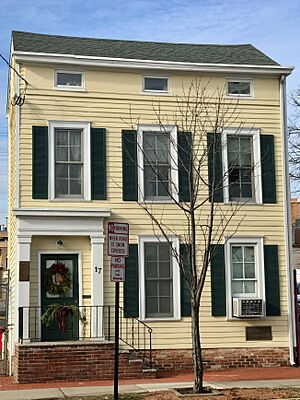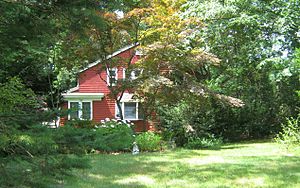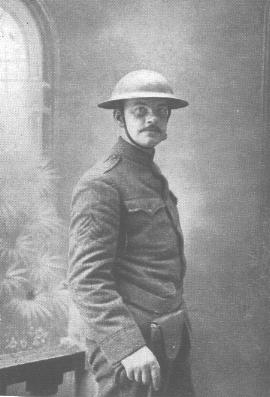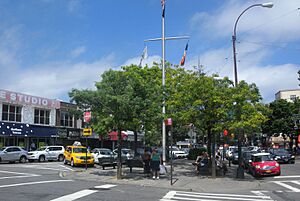Joyce Kilmer facts for kids
Quick facts for kids
Joyce Kilmer
|
|
|---|---|
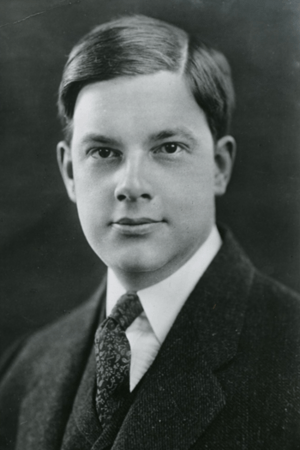
Kilmer's Columbia University yearbook photograph, c. 1908
|
|
| Born | Alfred Joyce Kilmer December 6, 1886 New Brunswick, New Jersey, U.S. |
| Died | July 30, 1918 (aged 31) near Seringes-et-Nesles, Marne, France |
| Cause of death | Killed in action |
| Occupation | Poet, journalist, editor, lecturer, soldier |
| Alma mater | Columbia University (A.B. 1908) Rutgers College |
| Period | 1909–1918 |
| Genre | Poetry, literary criticism, essays, Catholic theology |
| Notable works | Trees and Other Poems (1914), Main Street and Other Poems (1917) |
| Spouse | Aline Murray (1908–1918, his death) |
| Children | 5 |
| Signature | |
 |
|
Alfred Joyce Kilmer (born December 6, 1886 – died July 30, 1918) was an American writer and poet. He is best known for his short poem called "Trees" (1913). This famous poem was published in a collection titled Trees and Other Poems in 1914.
Kilmer wrote many poems that celebrated the simple beauty of the natural world. He also wrote about his Catholic faith. Besides being a poet, Kilmer was also a journalist, a literary critic (someone who reviews books), a lecturer, and an editor.
When World War I began, Kilmer was seen as a leading American Catholic poet. He joined the New York National Guard. In 1917, he was sent to France with the 69th Infantry Regiment, known as the "Fighting 69th." He was killed by a sniper's bullet in 1918 during the Second Battle of the Marne. He was only 31 years old.
Joyce Kilmer was married to Aline Murray, who was also a talented poet and author. They had five children together. While many of his works are not widely known today, "Trees" remains very popular. It is often included in poetry anthologies (collections of poems). Some critics have said Kilmer's work is too simple or old-fashioned. Many writers, like Ogden Nash, have even made fun of his poem "Trees."
Contents
Joyce Kilmer's Life Story
Early Life and School Days: 1886–1908
Joyce Kilmer was born on December 6, 1886, in New Brunswick, New Jersey. He was the youngest of four children. His mother, Annie Ellen Kilburn, was a writer and composer. His father, Dr. Frederick Barnett Kilmer, was a doctor and chemist for the Johnson and Johnson Company. He even invented their famous baby powder!
Joyce was named after two priests from his family's church, Christ Church. The Kilmer family lived in New Brunswick until 1892. Their old home is still there and has a small museum about Joyce Kilmer.
In 1895, at age 8, Kilmer started at Rutgers College Grammar School. He was the editor of the school paper, the Argo. He loved classic stories but found Greek difficult. He won an award for public speaking and earned a scholarship to Rutgers College.
After graduating from grammar school in 1904, he went to Rutgers College. There, he worked on the campus newspaper, the Targum. However, he struggled with math and had to repeat a year. So, he decided to transfer to Columbia University in New York City.
At Columbia, Kilmer was very active. He was vice-president of a literary society and worked on the campus newspaper. He earned his Bachelor of Arts degree and graduated on May 23, 1908. Soon after, on June 9, 1908, he married Aline Murray. She was also a poet and they had been engaged since his time at Rutgers. They had five children: Kenton, Rose, Deborah, Michael, and Christopher.
Writing and Faith: 1909–1917
In late 1908, Kilmer taught Latin at Morristown High School in Morristown, New Jersey. He also started sending his essays and poems to magazines. He reviewed books for several publications, including The New York Times. By 1909, he decided to focus only on writing.
From 1909 to 1912, Kilmer worked for Funk and Wagnalls. They were creating a new edition of The Standard Dictionary. Kilmer's job was to define words. He was so fast and good at it that they put him on a regular salary.
In 1911, Kilmer's first book of poems, Summer of Love, was published. He later said some of the poems were inspired by true love and he was not ashamed of them.
By 1912, Kilmer was a special writer for The New York Times Review of Books. He also gave many lectures. He moved to Mahwah, New Jersey, where he lived until he went to war. He became a well-known poet and speaker. He was known for being able to give speeches without much preparation.
A sad event changed the Kilmer family's life. Their daughter Rose (born 1912) became sick with poliomyelitis (a serious disease). This led the family to seek comfort in their faith. Joyce and Aline Kilmer decided to become Catholic in 1913. Kilmer wrote that his daughter's illness helped him find faith.
In August 1913, Kilmer's poem "Trees" was published in Poetry magazine. This poem made him very popular across the United States. He became a successful lecturer, especially to Catholic audiences. His friend and editor, Robert Holliday, said Kilmer was like the "poet of the Catholic Church."
Trees and Other Poems was published in 1914. This collection also included another popular poem, "The House With Nobody In It." Kilmer continued to be very busy. He gave many lectures, published essays, and wrote more poetry. He became a poetry editor for Current Literature in 1915. Before America joined World War I, Kilmer published four more books between 1916 and 1917.
War Years: 1917–1918
In April 1917, just a few days after the United States entered World War I, Kilmer joined the army. He enlisted in the Seventh Regiment of the New York National Guard. In August, he was assigned to the 165th Infantry Regiment. This was the famous "Fighting 69th" regiment. He quickly became a sergeant.
Kilmer could have become an officer, but he refused. He said he would rather be a sergeant in the Fighting 69th than an officer anywhere else.
Before he left for Europe, his daughter Rose died. Twelve days later, his son Christopher was born. Kilmer had planned to write a book about the war called Here and There with the Fighting Sixty-Ninth. He arrived in France in November 1917. He wrote to his wife that he hadn't written much poetry or prose. He said he was "storing up a lot of memories to turn into copy."
Kilmer never wrote that book. However, he did write some poems and short stories. His most famous poem from this time was "Rouge Bouquet" (1918). It honored the soldiers from his regiment who died in a German attack. Twenty-one men were buried when a German artillery shell hit their trench. Nineteen of them died.
Kilmer wanted to do more dangerous work. In April 1918, he joined the military intelligence section of his regiment. He wrote to his wife, Aline, that he loved his new work. He said it had "a double share of glory and thrills." His fellow soldiers respected him for his bravery. He often chose the most dangerous missions. This bravery, sadly, led to his death.
Death and Burial
The Second Battle of Marne involved very heavy fighting in July 1918. On July 30, 1918, Kilmer volunteered for a dangerous mission. He went with Major "Wild Bill" Donovan to lead an attack.
During the day, Kilmer led a small group to find a German machine gun. Later, his friends found him. They thought he was just looking over a small hill. But when he didn't answer, they ran to him and found him dead. A sniper's bullet had hit him in the brain, killing him instantly.
Military records show Kilmer died on the battlefield near Muercy Farm, France. He was 31 years old. For his bravery, France gave him the Croix de Guerre (War Cross) after his death.
Kilmer was buried in the Oise-Aisne American Cemetery and Memorial in France. There is also a monument to him in the Kilmer family plot at Elmwood Cemetery in North Brunswick, New Jersey. A special church service was held for him in St. Patrick's Cathedral in New York City on October 14, 1918.
Joyce Kilmer's Works
"Trees"
Joyce Kilmer is mostly famous for one poem: "Trees" (1913). It was first published in Poetry: A Magazine of Verse in August 1913. It was also the main poem in his collection Trees and Other Poems (1914).
According to Kilmer's oldest son, Kenton, the poem was written on February 2, 1913. The family was living in Mahwah, New Jersey, at the time. Kenton said his father wrote it in an upstairs room, by a window looking out at a wooded hill. It was written in a small notebook where his parents kept copies of their poems.
Many places claim that a specific tree inspired Kilmer's poem. This includes Rutgers University and towns like Mahwah. However, Kenton Kilmer said his father did not have one particular tree in mind. He said his father meant "just any trees or all trees." He imagined trees that would get rain or snow and be good places for robins to nest. They would also need branches reaching up "for the line about 'lifting leafy arms to pray.'"
The poem's simple message is likely why it remains popular. Robert Holliday, Kilmer's friend and editor, said "Trees" speaks "to the simplest of hearts." He added that this "impeccable lyric" made Kilmer famous more than all his other writings.
Because of its popularity, "Trees" has been made fun of many times. Even famous poets have parodied it. The first lines, "I think that I shall never see / A poem lovely as a tree," are easy to copy. One well-known parody is "Song of the Open Road" by American poet Ogden Nash:
- I think that I shall never see
- A billboard lovely as a tree.
- Indeed, unless the billboards fall,
- I'll never see a tree at all.
Kilmer's Legacy
Joyce Kilmer died at age 31. This meant he didn't have the chance to grow as a poet. Many modern critics think "Trees" is too simple. Because of this, much of Kilmer's other work is not well known today. Only a few of his poems appear in collections. Almost none, except "Trees" and "Rouge Bouquet", are still widely popular.
Kilmer wrote his poems between 1909 and 1918. This was a time when older styles of poetry were losing favor. New styles, like Modernism, were becoming popular. Kilmer's poems are traditional and follow classic rules. He is seen as one of the last poets of the Romantic era. Some critics say his style is too old-fashioned and sentimental.
In the 1940 movie "The Fighting 69th," actor Jeffrey Lynn played Sergeant Joyce Kilmer.
Tributes to Joyce Kilmer
Many places are named after Joyce Kilmer:
- Sgt. Joyce Kilmer Triangle in Midwood, Brooklyn, New York City, is a small park named after him.
- Joyce Kilmer Park in the Bronx, New York, near Yankee Stadium, is also named in his honor.
- The Joyce Kilmer Memorial Forest in North Carolina is part of the Nantahala National Forest. It is a beautiful forest named after him.
- A service plaza on the New Jersey Turnpike in East Brunswick is named after Kilmer.
- Kilmer Middle School in Vienna, Virginia.
- Joyce Kilmer School in Mahwah, New Jersey.
- Joyce Kilmer Elementary School in Cherry Hill, New Jersey.
- Joyce Kilmer Natural Area in Bald Eagle State Forest, Pennsylvania.
- Joyce Kilmer School in West Roxbury (Boston), MA.
Published Works
- 1911: Summer of Love (poetry)
- 1914: Trees and Other Poems (poetry)
- 1916: The Circus and Other Essays (essays)
- 1917: Main Street and Other Poems (poetry)
- 1917: Dreams and Images: An Anthology of Catholic Poets (a collection of poems he edited)
- 1917: Literature in the Making by some of its Makers (literary criticism)
- 1918: Poems, Essays and Letters in Two Volumes (published after his death)
- 1919: Kilmer's unfinished history of the Fighting 69th was printed in Father Duffy's Story by Francis P. Duffy.
- 1921: The Circus and Other Essays and Fugitive Pieces (published after his death)
Images for kids
-
Plaque honoring Kilmer in Central Park, New York City
-
Plaque erected at the Joyce Kilmer Memorial Forest in Graham County, North Carolina
See also
- Joyce Kilmer Memorial Bad Poetry Contest
- List of places named after Joyce Kilmer
- Category:Poetry by Joyce Kilmer


